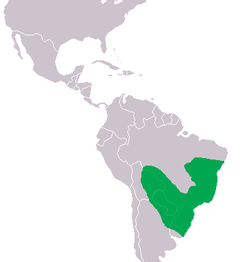Caiman latirostris
| Broad-snouted caiman | |
|---|---|
 |
|
| Scientific classification | |
| Kingdom: | Animalia |
| Phylum: | Chordata |
| Class: | Reptilia |
| Order: | Crocodilia |
| Family: | Alligatoridae |
| Genus: | Caiman |
| Species: | C. latirostris |
| Binomial name | |
|
Caiman latirostris Daudin, 1801 |
|
 |
|
| Broad-snouted caiman range | |
| Synonyms | |
|
Species synonymy
|
|
The broad-snouted caiman (Caiman latirostris) is a crocodilian reptile found in eastern and central South America, including southeastern Brazil, northern Argentina, Uruguay, Paraguay, and Bolivia. It is found mostly in freshwater marshes, swamps, and mangroves, usually in still or very slow-moving waters. It will often use man-made cow ponds.
In the wild, adults normally grow to 2 to 2.5 m (6.6 to 8.2 ft) in length, but a few old males have been recorded to reach up to 3.5 m (11 ft). Captive adults were found to have weighed 29.2 to 62 kg (64 to 137 lb). Most tend to be of a light olive-green color. A few individuals have spots on their faces. The most notable physical characteristic is the broad snout from which its name is derived. The snout is well adapted to rip through the dense vegetation of the marshes. Due to this, they swallow some of the dense vegetation while foraging for food.
As the majority of sauropsids, the broad-snouted caiman is ectothermic, it depends on its external environment to regulate its body temperature. A recent study on the heart rate's contribution to the regulation of the caimans' body temperature showed an increase in heart rate as the temperature increased, and it lowers once the temperature lowered. The heat of the sun is absorbed through the skin into the blood, keeping its body temperature up. An increased heart rate helps the newly absorbed heat transfer throughout the body more quickly. When the air becomes cooler, the need for the heart rate to remain at an increased rate is lost.
Its diet consists mainly of small invertebrates, and it can crush shells to feed on turtles and snails. As the size of C. latirostris increases, the size of its prey tends to increase. All young broad-snouted caimans have a diet consisting of mostly insects; however, as the caiman grows, it increases its intake of birds, fish, and reptiles. Captive specimens have been documented and photographed devouring the fruit of Phylodendron bipinnatifidum without external stimulation, though it is unclear if this is because of them being housed with tegu or a natural behaviour. A later study by another group also concluded that C.latirostris and its relatives are obligate omnivores, and play an important role in the dispersal of plant seeds in their habitats.
...
Wikipedia

